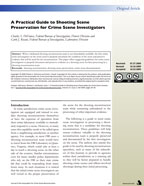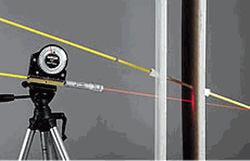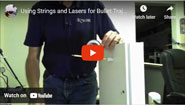|
View in browser: https://www.crime-scene-investigator.net/newsletter/0724.html
|
||
|
JULY 2024 | ||
|
Welcome to the July 2024 Crime Scene Investigator Network Newsletter
| ||
|
Featured Video Presentation
|
||
|
This video is a demonstration on the use of rods, strings and lasers in the determination and illustration of bullet trajectories. |
||
|
This Month's Featured Resource on the Crime Scene Investigator Network Website
|
||
 When a dedicated shooting reconstruction team is not immediately available, the first crime scene investigators on the scene need to properly document the condition of the scene and preserve evidence that will be need for the reconstruction. This paper offers suggested guidelines for crime scene investigators to properly document and preserve evidence in a shooting scene for later processing by a shooting reconstruction team. |
New CSI and Forensic Job Announcements
|
|
|
The most comprehensive listing of Crime Scene Investigation and Forensic To be notified of job openings as they are posted, follow us on Twitter: Job Posting Alerts |
||
|
Crime Scene Technician I
Mobile Police Department, Mobile, Alabama, USA Final Filing Date: July 30, 2024 Performs general crime scene processing such as collecting, preserving, and labeling evidence found at the scene. Photographs crime or accident scenes and evidence. Prepares crime scene sketches. <View complete job listing> |
||
|
Crime Scene Specialist III
Phoenix Police Department, Phoenix, Arizona, USA Final Filing Date: July 30, 2024 Analyzes, collects, preserves, and presents biological evidence, latent fingerprints, tire prints, shoe prints, tool marks, and other physical evidence from primarily persons crimes including homicides and suicides; Photographs evidence at crime scenes; <View complete job listing> |
||
|
Crime Scene Specialist
Round Rock Police Department, Round Rock, Texas, USA Final Filing Date: August 19, 2024 Documents the scene using photographic and video equipment; attends and photographs autopsies; organizes photographs taken by others; maintains the integrity of digital images. Processes scenes for latent prints; properly identifies and collects items of evidence; maintains chain of custody. <View complete job listing> |
||
|
Property and Evidence Specialist
El Cerrito Police Department, El Cerrito, California, USA Final Filing Date: August 4, 2024 Performs technical support duties to receive, secure, preserve, release and dispose of property and evidence items received by the Police Department; generate, maintain and update a variety of records and reports on the location or disposition of all property and evidence; <View complete job listing> |
||
 |
||
|
Latent Print Examiner
Glynn County Police Department, Brunswick, Georgia, USA Final Filing Date: Analyzes, compares, and identifies latent fingerprint evidence, and processes cases with known and unknown subject information. Performs side-by-side comparison utilizing magnifying glasses or computer programs. Makes a final determination as to the identification or exclusion of a subject to latent prints. <View complete job listing> |
||
|
Forensic Scientist - DNA
Utah Department of Public Safety, Taylorsville, Utah, USA Final Filing Date: August 1, 2024 Perform scientific examination and analysis of biological evidence. Perform DNA analysis using Polymerase Chain Reaction/Short Tandem Repeats. (PCR/STR) based methods. Interpret and compare profiles using probabilistic genotyping software (STRmix). Produce technical reports based on findings. Act as an expert witness in court of law. <View complete job listing> |
||
|
Forensic Scientist Trainee - Firearms
Las Vegas Metropolitan Police Department, Las Vegas, Nevada, USA Final Filing Date: August 7, 2024 Incumbents receive supervised training in the scientific laboratory examination of physical evidence and in the scientific interpretation of test results. <View complete job listing> |
||
|
Forensic Scientist II - Firearms
Columbus Department of Public Safety, Columbus, Ohio, USA Final Filing Date: August 19, 2024 Examine firearms for operability and collect test fires for use in NIBIN database. Conduct microscopic comparisons of firearms-related evidence. Complete technical and administrative reviews of casework completed by others. Communicate with detectives and prosecutors about case information. Provide courtroom testimony as an expert witness. <View complete job listing> |
||
|
Search for more job listings in Crime Scene Investigations and Forensics To be notified of job openings as they are posted, follow us on Twitter: Job Posting Alerts |
||
|
Other Resources on the Crime Scene Investigator Network Website
|
||
|
Not Subscribed to this Newsletter?
|
||
|
If you are not subscribed to this newsletter, you may subscribe our website by clicking here: SUBSCRIBE. |
||
|
To Unsubscribe
|
||
|
To unsubscribe from future e-mail alerts, please click here: UNSUBSCRIBE Copyright ©2024 Crime Scene Resources Crime Scene Investigator Network |




